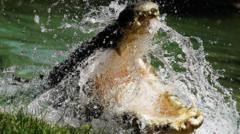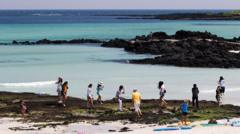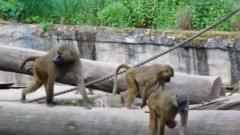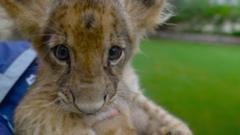In Darwin, where rising crocodile populations and human encounters create tension, government rangers and educational programs aim to ensure safety. Despite efforts to keep the public safe, the debate over managing croc numbers continues, with both conservation and economic interests at play.
Navigating the Balance: Crocodile Conservation and Management in Australia's Northern Territory

Navigating the Balance: Crocodile Conservation and Management in Australia's Northern Territory
As saltwater crocodile populations surge in Australia's Northern Territory, authorities face challenging decisions regarding their management to ensure public safety while preserving these apex predators.
In the early morning light over Darwin Harbour, Kelly Ewin, a dedicated government ranger, finds herself suspended between two critical responsibilities: safeguarding human life and managing the rapid increase of saltwater crocodiles in Australia’s Northern Territory (NT). The NT, often referred to as Australia’s crocodile capital, is home to around 100,000 wild saltwater crocodiles – the largest living reptiles on Earth. The region’s many water bodies offer both ideal crocodile habitats and a tantalizing environment for local recreation.
About half a century ago, these crocodiles faced near extinction as hunting for their prized skins took its toll. Fortunately, the 1971 hunting ban catalyzed a notable population recovery. However, while now no longer endangered, the explosive growth in croc numbers has ignited a crucial dilemma: how best to manage these formidable predators while ensuring public safety.
“Negative public perception can escalate quickly, leading to political pressures for unsound solutions,” warns crocodile expert Prof Grahame Webb. Notably, fatal crocodile incidents in Australia are rare, but the recent death of a 12-year-old in NT reignited community fears and discussions regarding the coexistence of humans and these apex predators.
Ewin’s team, tasked with managing croc populations, deploys traps around Darwin and operates during this peak breeding season. They often have to euthanize captured crocs instead of relocating them due to their tendency to return to their original haunts. "Every croc we take out, reduces the risk of dangerous encounters,” Ewin explains, highlighting the balance between capturing and conserving.
Education is fundamental to minimizing human-crocodile conflict. The NT government’s "Be Crocwise" program promotes awareness about safe interactions with crocodiles, with plans for adaptations in regions like Florida and Southeast Asia, aiming to refine human-crocodile coexistence practices.
Following last year’s tragedy, NT authorities instituted an expanded crocodile management strategy, raising the annual culling quota from 300 to 1,200. This proactive approach aims to maintain a balance between growing human populations, nearing 250,000, and their reptilian counterparts.
Crocodiles aren't just controversial but also economically significant. They attract tourists seeking thrill through experiences like “croc jumping” and fuel a lucrative leather industry, with designer brands eagerly sourcing crocodile skins. Partnerships between crocodile farmers and local Indigenous communities aim to distribute economic benefits, helping both conservation efforts and cultural heritage preservation.
Yet concerns persist around the ethics of farming crocodiles, particularly regarding their confinement. Critics argue that keeping these social reptiles in isolated pens can be damaging, both physically and mentally.
As Darwin continues navigating the complexities surrounding its crocodile population, one thing is clear: the conversation regarding their management, conservation, and coexistence with humans is far from settled. The need to protect both people and a species that plays a key ecological role remains a contemporary challenge, requiring innovative strategies and community engagement to ensure that one of the world’s oldest surviving species can thrive without compromising human safety.
About half a century ago, these crocodiles faced near extinction as hunting for their prized skins took its toll. Fortunately, the 1971 hunting ban catalyzed a notable population recovery. However, while now no longer endangered, the explosive growth in croc numbers has ignited a crucial dilemma: how best to manage these formidable predators while ensuring public safety.
“Negative public perception can escalate quickly, leading to political pressures for unsound solutions,” warns crocodile expert Prof Grahame Webb. Notably, fatal crocodile incidents in Australia are rare, but the recent death of a 12-year-old in NT reignited community fears and discussions regarding the coexistence of humans and these apex predators.
Ewin’s team, tasked with managing croc populations, deploys traps around Darwin and operates during this peak breeding season. They often have to euthanize captured crocs instead of relocating them due to their tendency to return to their original haunts. "Every croc we take out, reduces the risk of dangerous encounters,” Ewin explains, highlighting the balance between capturing and conserving.
Education is fundamental to minimizing human-crocodile conflict. The NT government’s "Be Crocwise" program promotes awareness about safe interactions with crocodiles, with plans for adaptations in regions like Florida and Southeast Asia, aiming to refine human-crocodile coexistence practices.
Following last year’s tragedy, NT authorities instituted an expanded crocodile management strategy, raising the annual culling quota from 300 to 1,200. This proactive approach aims to maintain a balance between growing human populations, nearing 250,000, and their reptilian counterparts.
Crocodiles aren't just controversial but also economically significant. They attract tourists seeking thrill through experiences like “croc jumping” and fuel a lucrative leather industry, with designer brands eagerly sourcing crocodile skins. Partnerships between crocodile farmers and local Indigenous communities aim to distribute economic benefits, helping both conservation efforts and cultural heritage preservation.
Yet concerns persist around the ethics of farming crocodiles, particularly regarding their confinement. Critics argue that keeping these social reptiles in isolated pens can be damaging, both physically and mentally.
As Darwin continues navigating the complexities surrounding its crocodile population, one thing is clear: the conversation regarding their management, conservation, and coexistence with humans is far from settled. The need to protect both people and a species that plays a key ecological role remains a contemporary challenge, requiring innovative strategies and community engagement to ensure that one of the world’s oldest surviving species can thrive without compromising human safety.

















